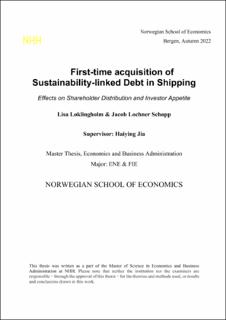| dc.description.abstract | The allocation of capital to green projects has increased in recent years, as companies across
industries increase their commitments to become more sustainable. In a regulatory
environment where sustainability and an environmental perspective have become an issue of
the highest priority, decarbonization is high on the agenda. Presently, the shipping industry is
facing ever greater challenges, most notably regarding fuel and energy consumption whilst
committing to the sustainable energy transition. Consequently, shipping companies must make
important financial decisions regarding technological improvements of their fleet in an evertightening
sea of international regulations.
Since the Paris Agreement was signed in December 2015, the evolution of sustainabilitylinked
finance instruments has grown exponentially. The growth in such instruments is, in
part, a reflection of the pressure from regulators, consumers, and investors on businesses to
prioritize ESG issues and sustainability in their strategic decision-making. As a result,
shipping companies are leveraging sustainability-linked finance instruments, primarily
through sustainability-linked loans and sustainability-linked bonds, to communicate their
sustainability targets and compensate investors if sustainability targets are missed. The latter
raises an important question concerning whether sustainability-linked debt financing attracts
certain shareholders - and does it affect investor appetite?
This study addresses this question by investigating the change in shareholder distribution for
institutional, family, and public investors following firms’ first-time acquisition of
sustainability-linked debt instruments. Employing fixed effect panel regression models and
difference-in-difference models, we find evidence of increased ownership for institutional and
public investors following shipping firms’ first-time acquisition of sustainability-linked debt.
Our findings from the difference-in-differences models suggest that institutional and public
investors reallocate capital to firms that acquire sustainability-linked debt compared to peers
that do not. Findings for family investors are inconclusive.
The implications of the findings are that the shareholder distribution amongst institutional and
public shareholders in publicly listed shipping companies increases after the first-time
acquisition of sustainability-linked debt. We also find that investor appetite is higher for firms
that acquire sustainability-linked debt compared to shipping firms that do not. | en_US |

